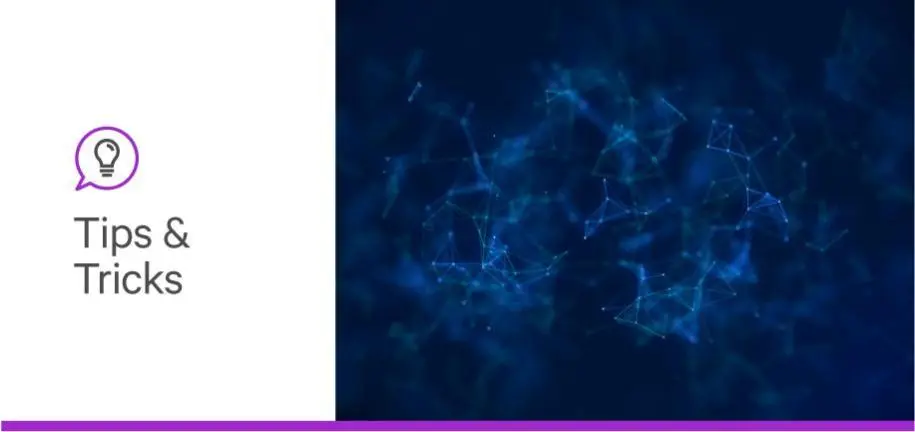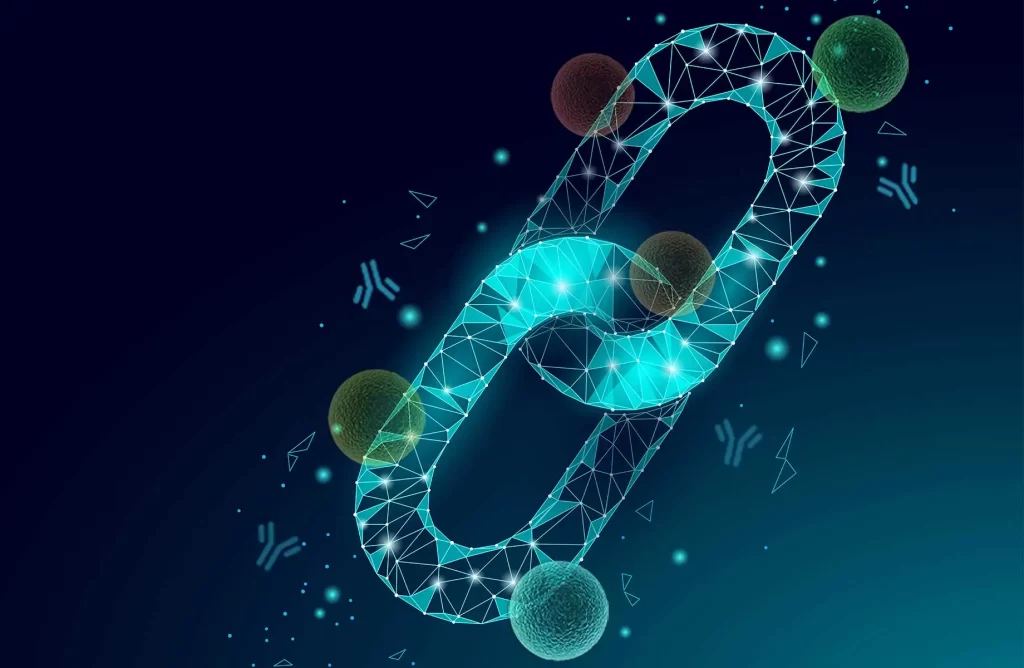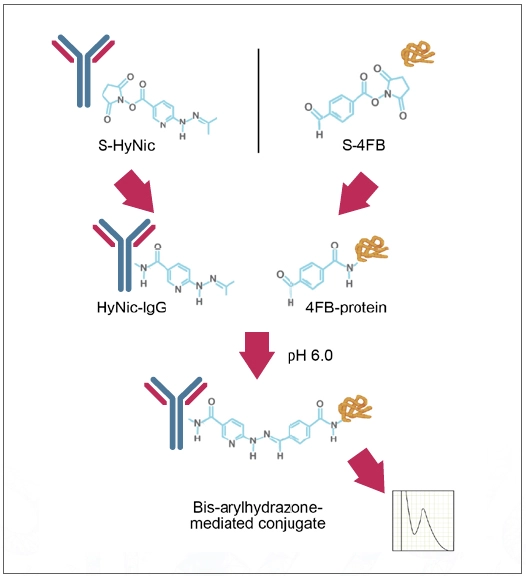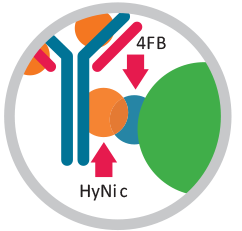
Vector Laboratories is closed for the President’s Day on Monday, February 19th. We will be back in the office on Tuesday, February 20th.
We will respond to emails upon our return. Have a wonderful day.
Menu
Vector Laboratories is closed for the President’s Day on Monday, February 19th. We will be back in the office on Tuesday, February 20th.
We will respond to emails upon our return. Have a wonderful day.

Advances in cellular imaging, diagnosis, and drug discovery require biomolecules that have the whole package: biocompatibility, specificity, ease of penetration, ease of monitoring, and so on. Bioconjugation chemistry has turned this into reality, with the ability to modify proteins, nucleic acids, and carbohydrates opening many doors to ground-breaking targeted therapies and imaging methods.
Before delving deeper into its applications, let’s first define bioconjugation.


Bioconjugation is the chemical linking of two molecules to form a single hybrid, where at least one member of the partnership is a biomolecule. This partnership is a perfect manifestation of the motto the whole is greater than the sum of its parts. In other words, the resulting product retains the activity of each component yet also gains a novel function that is not possible with either molecule alone.
Bioconjugation typically involves adding distinct but complementary functional groups to each of the two biomolecules, enabling them to bind to one another. This is achieved through a process known as modification, whereby linkers are attached to amines or thiol groups present on the biomolecules before they are mixed together.
Common examples of bioconjugates include antibodies bound to fluorophores, which can both recognize a target analyte and produce a measurable readout to confirm its presence, and proteins attached to agarose beads that can be used to immunoprecipitate a specific binding partner from solution with no need for secondary reagents.
You will come across bioconjugation in a plethora of applications, from protein detection to isolation to drug delivery. Dr. Craig Pow, Director of Technical Services at Vector Laboratories recently reviewed a number of case studies in a recent webinar.
One important aspect of bioconjugation is its contribution to drug targeting. In fact, approximately 80 antibody-conjugated drug candidates are being evaluated by FDA at the moment. In the first case study, the researchers aimed to increase the specificity of a Bristol-Myers Squibb drug towards the CXCR4 antigen expressed by T cells (1). This targeting strategy would help them greatly in delivering the drug to cells, where it could inhibit tyrosine kinase activity to block signal transduction cascade in tumor cells. Using SoluLINK® conjugation chemistry, they added an antibody to the drug. This conjugation increased the rate of cell entry and intracellular drug payload.
Another use of bioconjugation appeared in DNA-antibody barcoded arrays, which were developed for high-throughput single-cell protein detection. Here, the researchers first prepared a monolayer of single-stranded DNA microbeads on a glass surface. They hybridized these single strands with antibodies that captured a specific set of proteins in a solution. Using SoluLINK chemistry, they were able to conjugate the antibodies to complementary DNA and confirm the protein detection using sandwich ELISA (2). The use of bioconjugation could increase the accuracy of pathology and cell biology studies, as well as clinical diagnostics.
The genome sequencing of tumors and characterization of tumor cell markers also benefits from bioconjugation, as conventional immunolabeling methods fall short in identifying heterogeneous cell subpopulations. The Biomedical Engineering Department at Oregon Health and Science University developed a new method, in which they conjugated 14 different antibodies to oligonucleotides (3). The trick with these oligos was that they featured complementary fluorophore strands with photo-cleavable linkers. This allowed the researchers to quantify antibody and strand concentrations using cyclic immunofluorescence, while identifying antigens in human breast cancer tissues.
The strategy for bioconjugation sounds straightforward, but its application is a bit more complex than expected. More specifically, a perfectly functional bioconjugation strategy must meet the following criteria:
Meeting the above requirements is not always easy. Protein modification can be particularly challenging, especially when you have to selectively modify less frequent amino acid residues like tryptophan. Additionally, the polar molecules on protein surfaces tend to interfere with conjugation.

SoluLINK bioconjugation technology overcomes the challenges of conventional bioconjugation methods, enabling all classes of biomolecule (including antibodies, proteins, peptides, oligonucleotides, carbohydrates, drugs, and surfaces) to be bound to one another using affordable, off-the-shelf kits. Converting one biomolecule’s amines to aromatic hydrazine (HyNic) groups and the other’s to aromatic aldehyde (4FB) groups, the two entities, when mixed, can be joined by a stable bis-arylhydrazone conjugate bond.
Compared to other bioconjugation technologies, SoluLINK bioconjugation technology provides several advantages. These include faster conjugation reactions with greater labeling efficiency and lower reagent costs, superior bioconjugate stability in aqueous phases, and no cause for concern due to homodimer formation.
Most importantly, the bis-arylhydrazone bond is chromophoric, allowing researchers to quantify the number of linkers on each biomolecule prior to conjugation through a quick spectrophotometric absorbance reading at 354 nm. In turn, this enables the precise number of bound ligands to be determined.
A main benefit of the quantifiable bond is that it helps to ensure experimental reproducibility. Unlike pre-conjugated primary antibodies, where the number of labels per antibody is largely unknown (and may vary from lot to lot), SoluLINK bioconjugation technology both confirms that the labeling reaction has been successful and demonstrates its consistency between runs. This provides researchers with confidence in their results, no matter what downstream technique the labeled antibody or biomolecule will be used for.
Watch the entire on-demand webinar for more information on bioconjugation, including an overview of the SoluLINK chemistry and Bioconjugation portfolio from Vector Laboratories. And be sure to check out our Bioconjugation Resource Guide to help you get started.





Stay in the Loop. Join Our Online Community
Together we breakthroughTM

©Vector Laboratories, Inc. 2024 All Rights Reserved.